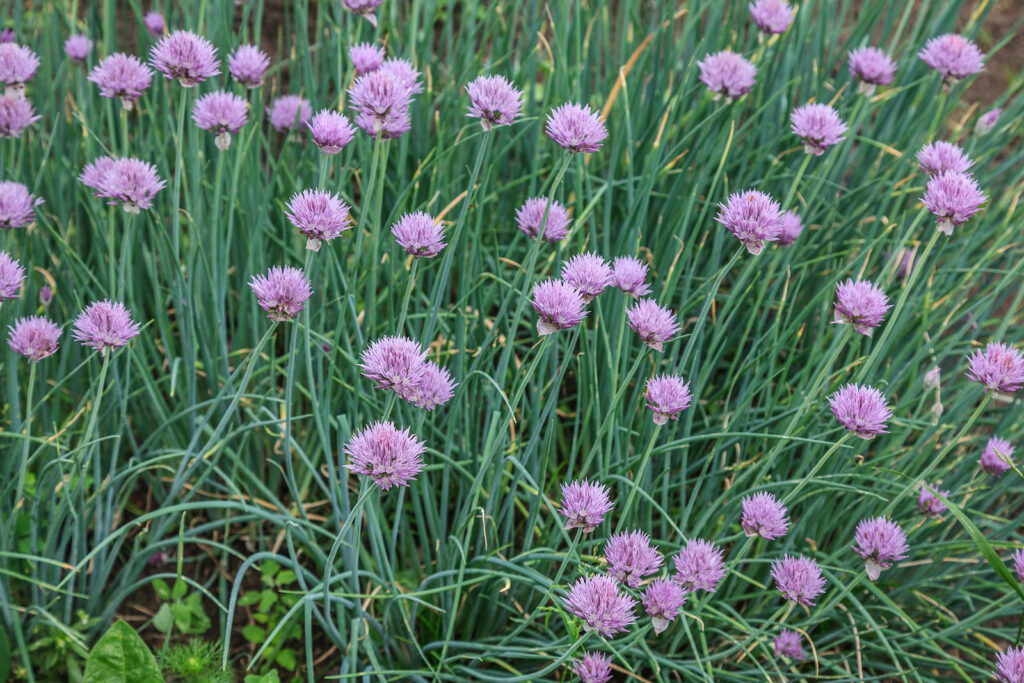Ornamental onions, Alliums, are perennial bulbs that bear gloves of small purple flowers held aloft on sturdy stems in early summer. Flowers are followed by decorative buff-colored seedheads. Strap-shaped leaves fade as the flowers appear—which may detract from the flowers.
Allium is a genus of strong-smelling bulbous herbs of the Lily family (including onions, leeks, and chives). Some 300 species are known in temperate regions and 70 are cultivated, mostly as vegetables but a few as ornamentals.
Hardy Alliums have flat or tubular leaves with tapering tips and flowers at the ned of erect bare stems in spherical clusters or slender spikes–the colors ranging from white to yellow, and through pinks to purple.
Alliums require rich, loamy soil, They can be grown from seeds, offsets, or small aerial bulblets in the flower heads.
Get to know ornamental onions
- Plant type: Hardy spring- or summer-blooming bulb
- Growing Zones and range: 4-10
- Hardiness: Half-hardy
- Height and width: 6” tall or taller; 4” wide or wider
- Flowers: Spherical clusters of small flowers are blue, purple, white
- Bloom time: Spring and summer
- Uses: Accent for beds and borders, cut flower
- Botanical name: Allium spp.
- Common name: Allium, ornamental onion
Where to plant Allium
- Plant allium in full sun or light shade, especially in Zones 7-10.
- Grow allium in sandy, well-drained soil.

When to plant Allium
- Plant allium bulbs in the fall. Set bulbs as deep as the bulb is wide.
Planting and spacing Allium
- Space allium 6” to 12” apart.
How to water and feed Allium
- Allium needs ample water but does not want wet soil.
- Alliums don’t need extra fertilizer if planted in average soil.
Allium care
- Remove weeds that will compete with alliums.
- Remove spent blossoms to encourage new blooms.
- Divide alliums every few years when crowded.
- Rodents often eat alliums.
Allium common problems
- Bulb rot caused by soil-borne fungi is common under damp conditions.
- Alliums are susceptible to onion flies and thrips.
Allium propagation
- Sow seed in spring.
- Remove offsets of bulbous species in autumn.
- Divide clump-forming, rhizomatous species in spring.
Allium varieties to grow
- Allium aflatenense, Persian onion: Asian species with round 3-inch wide bulbs; bears 4.5 inches wide umbels with densely paced red-violent flowers on 2-foot stems; leaves wither as flowers open.
- A. atropurpureum: species with 2.5-inch umbels of starry dark purple to purple-maroon flowers on 20-inch stems.
- A. caeruleum, blue globe onion, nodding onion: Siberian species with 2-inch wide umbels of 30 to 50 densely packed, start dark blue flowers o 2-foot stems.
- A. cernuum. nodding onion: North American species bears 2.5-inch umbels of 25 to 40 rose-purple, pink, or white flowers on 2-foot stems; flowers are nodding.
- Allium giganteum, giant onion: large bulbs produce 4 to 5-inch wide umbels of 50 to 100 starry rosy-purple flowers on 3 to 5-foot tall stalks; ‘White Giant’ produces white flowers.
- A. hybrids: many hybrid ornamental onions bear round or nearly round umbles; hybrids included ‘Gladiator’, ‘Globemaster’ ‘Lucy Ball’. ‘Mars’, and ‘Mount Everest.’
- A. moly, lily leek: bears flat, blue-green leaves with rounded 2-inch clusters of star-shaped golden yellow flowers.
- A. narcissiflorum, narcissus onion: dwarf species produce 1-inch wide umbels of six to ten flowers on 12-inch stalks; blooms are pinkish-purple.
- A. nigrum, black onion: produces somewhat flattened 3 to 4-inch wide umbles of 20 to 30-cup-shaped, creamy white flowers on 1.5-foot stalks; each flower has a dark green to black over in center.
- A. roseum, rosy garlic: bears loose 1 to 3-inch umbles of rose-pink flowers on 18-inch stems.
- A. schoenoprasum, chives: edible round leaves; bears cloverlike umbels of rosy pink flowers.
- A. sphaerocephalum, drumstick allium: taller species have wide clusters of deep reddish-purple flowers; grows to 3 feet tall.
- A. stellatum, prairie onion: North American wildflower bears 2-inch wide umbles of cup-shaped rose-pink flowers.
- A. tanguticum, lavender globe lily: bears lavender-blue 2-inch wide umbels on 2-foot stalks.
- A. triquetrum, three-cornered leek: 15-inch tall species produces three-cornered stems with nodding 3-inch wide umbels of lightly scented white flowers striped with green.
- A. tuberosum, garlic chives: edible foliage; bears rouned 2-inch wide umbles of starry white flowers on 2-foot high plants.
- A. ursinum, ramsons, wood garlic: dwarf species bears flattened 2-inch wide umbles of white flowers.
Related articles:















